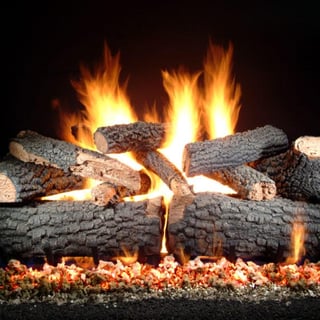
When installing a new gas fireplace system in your home, you’re going to be faced with the fateful decision of vented versus vent free. While there is a ton of information out there about both, there is some that isn’t exactly accurate and some that is downright false. Somewhere along the way, the vented system started to be the subject of these inaccuracies. So, we’ve decided to help clear the air by debunking 5 myths about vented gas logs.
Myth: Vent free systems are less expensive
This may be true for a builder, installing a high volume of systems. However, if you are a homeowner with an existing fireplace you essentially already have a vented system. In this case, going vent free would just be added labor and installation. If your home does not have a fireplace, there are short-term savings in a vent free system, but in the long-term, the vented system will still prove to be more cost effective and provide better resale value.
Myth: Vented systems require more maintenance than vent free systems
Though vent free systems are billed as being virtually maintenance free, they actually require a lot of upkeep. One of the biggest problems comes in monitoring the oxygen levels in the room where the system is. All fires need oxygen to burn. Both vented and vent free systems draw oxygen to fuel the fire from inside the room. Once that oxygen burns, carbon monoxide is left behind. With a vented system, that carbon monoxide escapes out of the chimney. The vent free system doesn’t have a chimney, so the carbon monoxide has nowhere to go but back into the room. This means that oxygen levels can be depleted, leading to carbon monoxide poisoning. Your system should come with an O2 monitor, but you do need to regularly check to make sure it is working. Also, due to the nature of combustion and the vent free system, water vapor is created every time it is used. This can lead to a build-up of moisture inside the unit, and in the room the unit is in, resulting in the growth of mold in your home.
Myth: A vented system lets your air conditioning out during the summer
This myth defies science, yet it still exists. We have always understood that hot air rises, and cold air, which is denser, drops. Cold air from your air conditioner cannot escape up your chimney, because cold air doesn’t go up.
Myth: A vented system lets too much heat out when being used
While a vented system does allow some heat to escape, it’s important to keep in mind which type of heat that is. There is convective heat (the heat that comes directly from the flames), and there is radiant heat. This is the heat that is created when the fire heats the things around it like the logs, the embers, or objects that are close to the fireplace. While some convective heat will escape, radiant heat will not.
Myth: Vented systems don’t create as much heat as vent free systems
This goes back convective versus radiant heat. Because convective heat does not escape a vent free system, it feels as though more heat was generated more quickly. However, more often than not, vent free systems feature fiber-logs, which don’t build radiant heat at all. This means that when you do shut the system off, the heat that was generated dissipates more quickly than that from a vented system, as the radiant heat is what keeps the warmth of the fire around after the fire has been turned off.
If you are installing a new system in your home and would like some help, advice, or would just like to browse our selection, please call our team at Casual Creations or just stop by and we’ll be happy to help.




